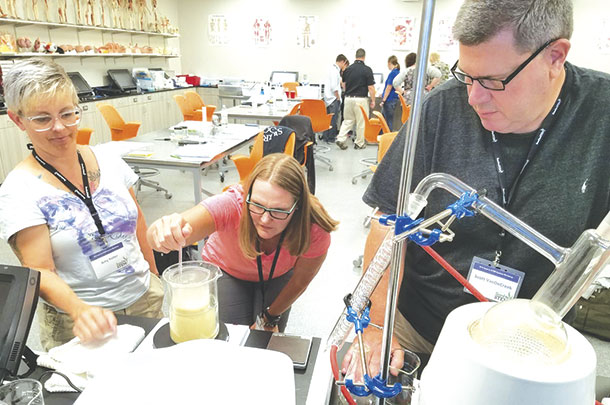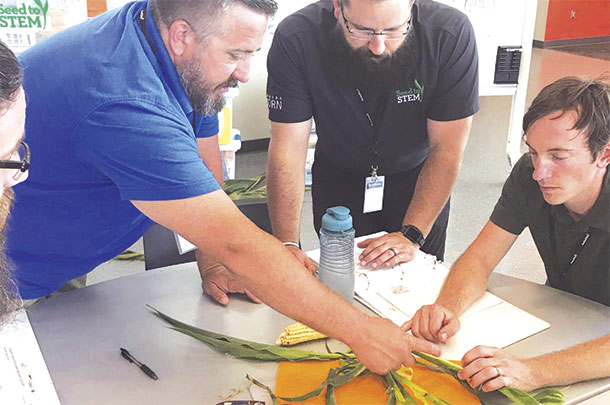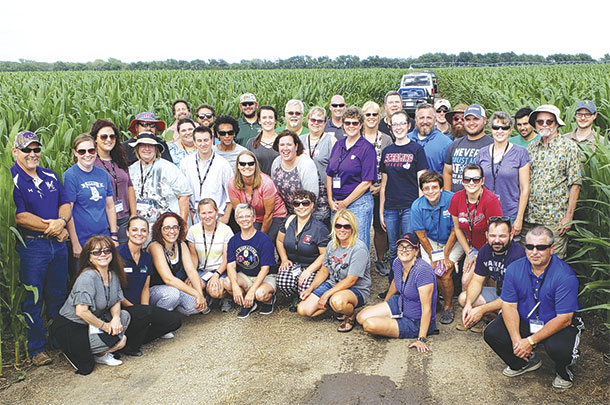Today, both are stronger than ever, with a continued message of agriculture education and opportunity, but their challenges are magnifying exponentially as America’s population becomes increasingly disconnected from agriculture.
Today, both new and established organizations are doing their part in the creation of programming that approaches and introduces agriculture education in new ways, each taking on different facets of the industry to provide youth, from pre-school through college, agricultural education opportunities.
A collegiate focus
Kansas City, Missouri-based Agriculture Future of America (AFA) Manager of Programs Johnna Wallingford says the approach each organization takes is important in providing a well-rounded agricultural education experience, citing AFA’s approach of qualification and development at the collegiate level as being instrumental to both industry partners and students.
“What makes us different in the ag education space is how we look to develop different leadership skills and competencies through our programming. Everything we do is on a competitive application basis: Students must apply, have their application scored and sometimes go through an interview process. Everything we do is development on behalf of the student,” she says.

The collegiate-focused program extends application to students throughout the U.S., offering one-of-a-kind experiences and connection opportunities, meeting students where they are in their educational and professional career development with information relevant to that particular stage.
“We don’t just talk about cattle, wheat and soybeans; we talk about preparing students for the workforce, and we do that through conversations with industry professionals,” says Wallingford. “Students have the opportunity to tour different industries through the institute program and make connections within those companies. We can talk to students all day long about what they should do. We can share the steps they should take, but actually connecting them to people in the industry and providing them firsthand experiences through a mentorship with industry professionals in the Leader Fellowship program is so much more beneficial.”
Making inroads in middle-and high-school classrooms
At the high school level, state commodity associations are engaging students in agriculture through workshops, curriculum and on-site experiences for educators.
Kansas Corn Commission Director of Education Sharon Thielen says the goal of the commission’s Seed to STEM program is getting agriculture into the classroom to start the conversation about the agriculture industry, biofuels and biotechnology.

The program partners with educators to develop and create agriculture-specific curriculum that aligns with what teachers are already teaching in their classroom, the Next Generation Science Standards.
“We don’t assume, as an organization, we know what teachers need. So we work with and contract with teachers to develop, communicate and create materials involving corn relevant to what is already in a Kansas science teacher’s curriculum,” says Thielen.
“A lot of the success of the program is up to the teachers that we work with. It’s about teachers teaching and mentoring other teachers. We are investing in teachers themselves.”
The program currently offers 10 lessons at the high school level and nine for middle school. The Seed to STEM summer workshop allows interested teachers the opportunity to spend two days learning about the corn and agriculture industries while becoming familiar with the hands-on laboratories. At the completion of the program, each educator is provided a kit containing over $500 of lab supplies.
Since 2016, over 160 Kansas educators have participated in the growing program.
Starting the conversation early
Efforts aren’t exclusive to middle school and beyond, however. Ag educators, corporate professionals and board members throughout the agriculture industry recognize the importance of beginning the conversation of food and agricultural production at an early age.
The Missouri Farmers Care effort, Ag Education on the Move (AEOTM), works to connect elementary students to agriculture through a 10-week, in-classroom learning experience provided by their district FFA members.

Luella Gregory, AEOTM program director, shares that students gain a lot more than the 10-week, one-hour lessons the program provides.
“Through hands-on education, AEOTM students learn about the journey their food makes from the farm to their dinner table while gaining an appreciation for farm families and the impact agriculture has on their everyday life,” she says.
Along with planting the seed early, the AEOTM group is changing the way the message is delivered by partnering with FFA chapters across the state of Missouri.
Gregory says the FFA partnership is a win-win for both student participants and for high school educators who have a passion for education. AEOTM provides the curriculum and supplies while local FFA chapters provide the presentation.
Conway, Missouri, FFA agriculture i0nstructor and FFA adviser Mary Anne Keck echoes Gregory’s sentiment. The chapter has participated in AEOTM for the past three years, and the gains for both FFA members and Conway third-grade students has been invaluable, she says.
“Being able to teach the agriculture lessons to the third-grade classrooms has been great for our chapter, and seeing the respect the younger kids show our FFA members from the get-go tells me how much they look up to their high school peers. By sharing their passion for agriculture, our members have the ability to provide a profound influence on younger students. AEOTM has helped to create a platform for educating the next generation of consumers and a recruiting tool for FFA.”
In its fifth year, AEOTM is seeing growth in rural and urban areas alike, and with FFA chapters helping to deliver the message of agriculture, the opportunities for expansion seem to be limitless for the program.
Finding a common ground
Today, less than 2 percent of the American population is involved in agriculture, and it has never been more important for those involved to share their stories with the other 98 percent than it is today.
At the end of the day, no matter which production method or diet you subscribe to, we all have to eat. If you eat, you’re involved in agriculture. Thankfully, through innovative educational programming, more of those disconnected from production agriculture are connecting their quality of life to American agriculture and the bounty it provides. ![]()
PHOTO 1: Students from across the U.S. participated in this 2017 crops science institute field trip. Photo courtesy of Agriculture Future of America.
PHOTO 2: Teachers practice distillation labs at a KCBA Seed to STEM workshop before taking lessons back to their classrooms.
PHOTO 3: Participants take part in a corn anatomy dissection lab.
PHOTO 4: Teachers learn about the corn and ethanol industries in a two-day workshop in Kansas. Photos courtesy of Kansas Corn Commission Seed to STEM program.
For more information on the programs featured in this article, visit their websites (Agriculture Future of America, Kansas Corn, Agriculture Education on the move).
Laura Handke is a freelancer writer based in Kansas.






